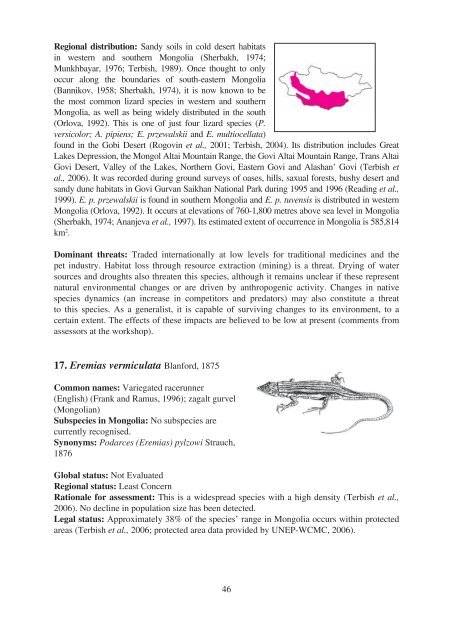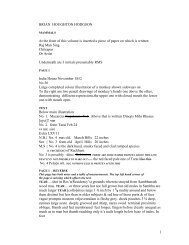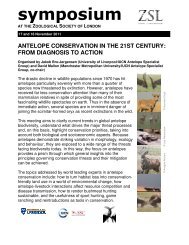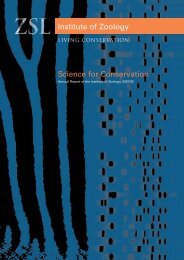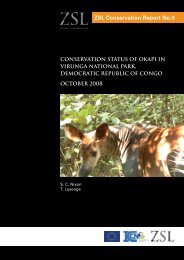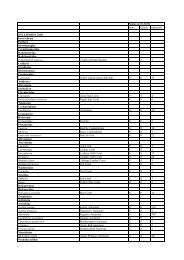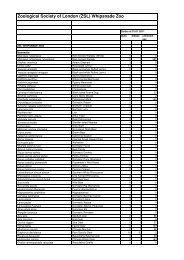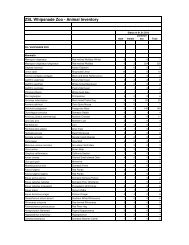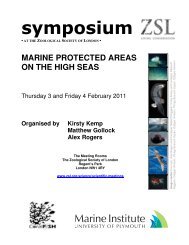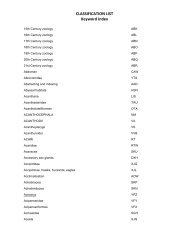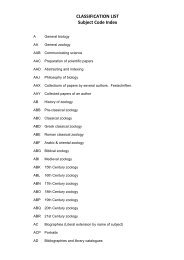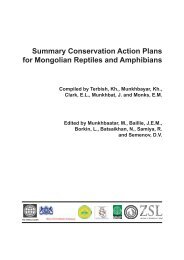Mongolian Red List of Reptiles and Amphibians - Web - Zoological ...
Mongolian Red List of Reptiles and Amphibians - Web - Zoological ...
Mongolian Red List of Reptiles and Amphibians - Web - Zoological ...
Create successful ePaper yourself
Turn your PDF publications into a flip-book with our unique Google optimized e-Paper software.
Regional distribution: S<strong>and</strong>y soils in cold desert habitats<br />
in western <strong>and</strong> southern Mongolia (Sherbakh, 1974;<br />
Munkhbayar, 1976; Terbish, 1989). Once thought to only<br />
occur along the boundaries <strong>of</strong> south-eastern Mongolia<br />
(Bannikov, 1958; Sherbakh, 1974), it is now known to be<br />
the most common lizard species in western <strong>and</strong> southern<br />
Mongolia, as well as being widely distributed in the south<br />
(Orlova, 1992). This is one <strong>of</strong> just four lizard species (P.<br />
versicolor; A. pipiens; E. przewalskii <strong>and</strong> E. multiocellata)<br />
found in the Gobi Desert (Rogovin et al., 2001; Terbish, 2004). Its distribution includes Great<br />
Lakes Depression, the Mongol Altai Mountain Range, the Govi Altai Mountain Range, Trans Altai<br />
Govi Desert, Valley <strong>of</strong> the Lakes, Northern Govi, Eastern Govi <strong>and</strong> Alashan’ Govi (Terbish et<br />
al., 2006). It was recorded during ground surveys <strong>of</strong> oases, hills, saxual forests, bushy desert <strong>and</strong><br />
s<strong>and</strong>y dune habitats in Govi Gurvan Saikhan National Park during 1995 <strong>and</strong> 1996 (Reading et al.,<br />
1999). E. p. przewalskii is found in southern Mongolia <strong>and</strong> E. p. tuvensis is distributed in western<br />
Mongolia (Orlova, 1992). It occurs at elevations <strong>of</strong> 760-1,800 metres above sea level in Mongolia<br />
(Sherbakh, 1974; Ananjeva et al., 1997). Its estimated extent <strong>of</strong> occurrence in Mongolia is 585,814<br />
km 2 .<br />
Dominant threats: Traded internationally at low levels for traditional medicines <strong>and</strong> the<br />
pet industry. Habitat loss through resource extraction (mining) is a threat. Drying <strong>of</strong> water<br />
sources <strong>and</strong> droughts also threaten this species, although it remains unclear if these represent<br />
natural environmental changes or are driven by anthropogenic activity. Changes in native<br />
species dynamics (an increase in competitors <strong>and</strong> predators) may also constitute a threat<br />
to this species. As a generalist, it is capable <strong>of</strong> surviving changes to its environment, to a<br />
certain extent. The effects <strong>of</strong> these impacts are believed to be low at present (comments from<br />
assessors at the workshop).<br />
17. Eremias vermiculata Blanford, 1875<br />
Common names: Variegated racerunner<br />
(English) (Frank <strong>and</strong> Ramus, 1996); zagalt gurvel<br />
(<strong>Mongolian</strong>)<br />
Subspecies in Mongolia: No subspecies are<br />
currently recognised.<br />
Synonyms: Podarces (Eremias) pylzowi Strauch,<br />
1876<br />
Global status: Not Evaluated<br />
Regional status: Least Concern<br />
Rationale for assessment: This is a widespread species with a high density (Terbish et al.,<br />
2006). No decline in population size has been detected.<br />
Legal status: Approximately 38% <strong>of</strong> the species’ range in Mongolia occurs within protected<br />
areas (Terbish et al., 2006; protected area data provided by UNEP-WCMC, 2006).<br />
46


